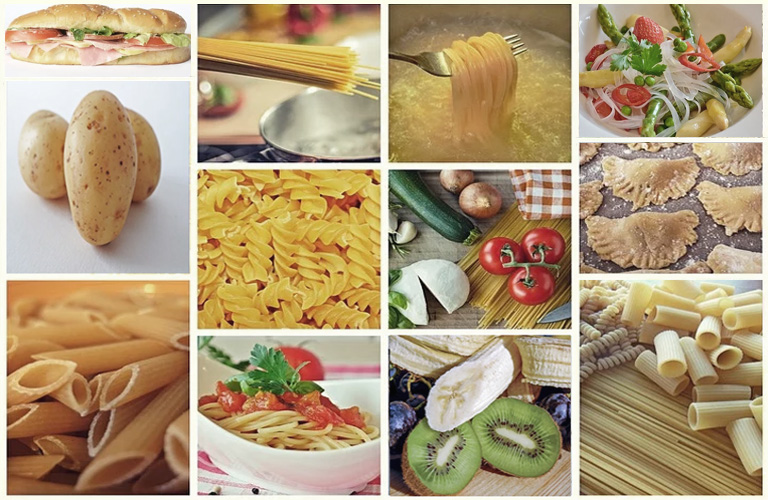Counting Carbs
Carbohydrate counting involves keeping track of the amount of carbohydrate in the foods you eat each day. Carbohydrates affect your blood glucose more than other nutrients. Your digestive system changes the carbohydrates you eat into glucose, a type of sugar that your body uses for energy. Simple carbs are more quickly digested and absorbed than complex ones, so simple carbs can raise your blood glucose levels faster and higher.
It makes sense for everybody, not only diabetics, to eat the more complex carbohydrates because they will be more gradually absorbed, and blood sugar highs and lows will be smaller. Whole foods with complex carbs will give you more minerals and vitamins, too, and are usually good sources of fiber.
Most foods that contain carbohydrates are nutritious and are an important part of a healthy diet. The goal is not to limit carbohydrates in the diet completely, but to make sure that you are not eating too many. Eating a regular amount of carbohydrates throughout the day can help keep your blood sugar level steady.
Most foods, even vegetables, have some carbohydrates. But most green, non-starchy vegetables are very low in carbohydrates.
The total amount of carbohydrates you eat in a day is the sum of the carbohydrate counts of everything you eat.
Most adults with diabetes should eat no more than 200 carbohydrate grams per day. The daily recommended amount for adults is 135 grams per day, but each person should have their own carbohydrate goal. Pregnant women need at least 175 grams of carbohydrates each day.
The amount of carbohydrate in foods is measured in grams. To count grams of carbohydrate in foods you eat, you’ll need to know which foods contain carbohydrates, learn to estimate the number of grams of carbohydrate in the foods you eat, and add up the number of grams of carbohydrate from each food you eat to get your total for the day.
When you count carbs in foods that you cook, you will have to measure the portion of food after cooking it. For example, cooked long grain rice has 15 grams of carbohydrate per 1/3 cup. If you eat a cup of cooked long grain rice, you will be eating 45 grams of carbohydrates.
Here are some examples of foods and servings sizes that have approximately 15 grams of carbohydrate:
- Half cup (107 grams) of canned fruit (without the juice or syrup)
- One cup (109 grams) of melon or berries
- Two tablespoons (11 grams) of dried fruit
- Half cup (121 grams) of cooked oatmeal
- One-third cup of cooked pasta (44 grams) (can vary with the shape)
- One-third cup (67 grams) of cooked long grain rice
- One-fourth cup (51grams) of cooked short grain rice
- Half cup (88 grams) cooked beans, peas, or corn
- One slice of bread
- One 6-inch tortilla
- Three cups (33 grams) popcorn (popped)
- One cup (240 milliliters) milk or soy milk
- Three ounces (84 grams) of baked potato
- 1/2 cup of starchy vegetables such as mashed potatoes, cooked corn, peas, or lima beans
- 3/4 cup of dry cereal or 1/2 cup cooked cereal
- 1 tablespoon of jelly
- Half cup (120 milliliters) fresh fruit juice or one small piece of fresh fruit, such as a small apple or orange

There are 3 major types of carbohydrates:
- Sugars - Sugars are found naturally in some foods and added to others. Sugar occurs naturally in these nutrient-rich foods: Fruits; Milk and milk products. Many packaged and refined foods contain added sugar: Candy; Cookies, cakes, and pastries; Regular (non-diet) carbonated beverages, such as soda; Heavy syrups, such as those added to canned fruit.
- Starches - Starches are found naturally in foods. Your body breaks them down into sugar after you eat them. The following foods have a lot of starch: Bread; Cereal; Legumes, such as beans and chickpeas; Pasta; Rice; Starchy vegetables, such as potatoes. Many also have fiber.
- Fiber - Fiber is the part of food that is not broken down by the body. It slows digestion and helps you feel fuller. Fiber can help you prevent constipation, lower your cholesterol levels, and control your weight.
Some foods, such as jelly beans, contain only unhealthy carbohydrates. Unhealthy carbohydrates are often food and drinks with added sugars. Although unhealthy carbohydrates can also provide energy, they have little to no nutrients.
Foods, such as animal proteins (all kinds of meat, fish, most types of cheese and eggs), have no carbohydrates. Other foods that do not contain carbohydrates include nuts, oils and other fats.
Some foods are so low in carbohydrates that you may not have to count them unless you eat large amounts. For example, most nonstarchy vegetables are low in carbohydrates. A 1/2-cup serving of cooked nonstarchy vegetables or a cup of raw vegetables has only about 5 grams of carbohydrate.
When you start counting your carbs, use a log book or notebook to help you track them. As time passes, and you become more familiar with which foods contain carbohydrates and how many grams of carbohydrate are in food you eat, it will get easier to estimate your carbs.
Human body turns all carbohydrates into energy.
Counting Carbs from Nutrition Labels
Packaged foods have labels that tell you how many carbohydrates a food has. Carbohydrates are measured in grams. You can find out how many grams of carbohydrate are in the foods you eat by checking the nutrition labels on food packages.You can use food labels to count the carbohydrates that you eat. When you are carb counting, a serving equals an amount of food that contains 15 grams of carbohydrate. The serving size listed on a package is not always the same as 1 serving in carbohydrate counting. For example, if a single-serving package of food contains 30 grams of carbohydrate, the package actually contains 2 servings when you are carb counting.
The food label will say what 1 serving size is and how many servings are in the package. If a bag of chips says that it contains 2 servings and you eat the entire bag, then you will need to multiply the label information by 2. For example, let's say the label on a bag of chips states that it contains 2 servings, and 1 serving of chips provides 11 grams of carbohydrate. If you eat the entire bag of chips, you have eaten 22 grams of carbohydrates.
Sometimes the label will list sugar, starch, and fiber separately. The carbohydrate count for a food is the total of these. Use only this total number to count your carbs.
For a healthy diet, limit the amount of added sugar that you eat and choose whole grains over refined grains.





